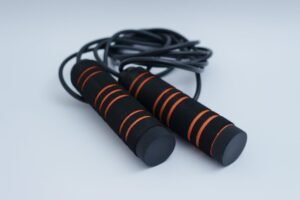Building muscle and strength requires more than just effort—it demands smart programming. Sets and reps are the foundation of any effective workout routine, but how many should you do? What’s the best rep range for muscle growth? And how can you avoid wasting time on ineffective training?
In this guide, we’ll break down everything you need to know about sets and reps, including:
- What reps and sets actually mean
- The science-backed ideal volume for muscle growth
- How to avoid “junk volume” (useless training)
- The best rep ranges for strength, hypertrophy, and endurance
- How to structure your home workouts for maximum results
Table of Contents
1. What Are Sets and reps? (The Basics)
Before diving into advanced strategies, let’s clarify the fundamentals.
Reps (Repetitions)
A rep (short for repetition) is one complete movement of an exercise. For example:
- 1 rep of a push-up = Lowering your chest to the ground and pushing back up.
- 1 rep of a squat = Bending your knees to 90 degrees and standing back up.
Sets
A set is a group of consecutive reps. For example:
- 3 sets of 10 push-ups = 10 reps, rest, 10 reps, rest, 10 reps.
Why This Matters
- Strength training typically uses lower reps (1-5) with heavy resistance.
- Muscle growth (hypertrophy) thrives in moderate rep ranges (6-12).
- Endurance training often involves high reps (20+) with lighter weights.
2. How Many Sets Should You Do Per Workout? (Science-Backed Volume)

One of the biggest debates in fitness is: “How many sets build the most muscle?”
The Research on Training Volume
- A 2017 meta-analysis (Brad Schoenfeld) found that 10+ sets per muscle per week led to the most growth.
- However, newer research suggests diminishing returns beyond 10-20 sets per week.
- Too much volume (“junk volume”) can actually hinder recovery and stall progress.
The Optimal Set Range for growth
| Goal | Weekly Sets per Muscle | Example (Chest Workout) |
|---|---|---|
| Maintenance | 5-9 sets | 3 sets of push-ups (Mon) + 3 sets of dumbbell presses (Thu) |
| Muscle Growth | 10-20 sets | 4 sets of push-ups, 4 sets of dips, 3 sets of flys (spread over 2-3 workouts) |
| Advanced Lifters | 15-20+ sets | Higher frequency (e.g., full-body workouts 4x/week) |
Key Takeaways:
- Beginners can grow with just 5-9 sets per muscle per week.
- Intermediate/advanced lifters need 10-20 sets weekly for continued growth.
- Avoid junk volume—extra sets that don’t contribute to gains but increase fatigue.
3. The Best Rep Ranges for Strength, Muscle, and Endurance
Not all rep ranges are equal. Here’s how to choose:
A. Strength (1-5 Reps)
- Best for maximal strength gains.
- Requires heavy resistance (e.g., weighted vest, heavy dumbbells).
- Example: 4 sets of 3-5 reps of pistol squats.
B. Hypertrophy (6-12 Reps)
- The sweet spot for muscle growth.
- Moderate weight, controlled tempo, close to failure.
- Example: 3 sets of 8-12 reps of push-ups with a slow negative.
C. Endurance (20+ Reps)
- Improves muscular stamina.
- Best for bodyweight exercises (e.g., lunges, air squats).
- Example: 2 sets of 30 reps of bodyweight squats.
Pro Tip:
- Vary rep ranges for balanced progress (e.g., strength-focused legs day, hypertrophy-focused upper body day) don’t stick to one for all muscle groups.
4. Avoiding “Junk Volume” (Wasted Workouts)

Junk volume refers to extra sets that don’t stimulate growth but drain energy.
Signs You’re Doing Junk Volume
Too many sets per muscle in one workout (e.g., 15 sets of push-ups in a single session).
Not training close to failure (stopping way before your muscles are fatigued).
Ultra-high reps (40+) with minimal resistance (unless endurance is your goal).
How to Fix It
- Stick to 4-6 hard sets per muscle per workout.
- Push closer to failure (last 2 reps should be tough but controlled).
- Focus on quality over quantity—better form > more reps.
5. Structuring Your Home Workout Plan
Now that you know the science, here’s how to apply it:
Option 1: Full-Body Workout (3x/Week)
- Squats: 3 sets x 8-12 reps
- Push-Ups: 3 sets x 8-12 reps
- Rows (using resistance bands): 3 sets x 10-15 reps
- Plank: 3 sets x 30-60 sec
Option 2: Upper/Lower Split (4x/Week)
Upper Day:
- Push-Ups: 4 sets x 8-12
- Dumbbell Rows: 4 sets x 10-15
- Pike Push-Ups: 3 sets x 8-12
Lower Day:
- Bulgarian Split Squats: 3 sets x 8-12
- Glute Bridges: 3 sets x 12-15
- Calf Raises: 3 sets x 15-20
For a complete routine that applies these set/rep principles, see our 5-Day Split Workout for Home Fitness and overall muscle growth.
6. Recommended Equipment for Home Training
Since were all about home training, having the right gear can make a huge difference. Here are some products to enhance your workouts:
1. Adjustable Dumbbells
- Perfect for progressive overload.
- Lifepro Adjustable Dumbbells Set (Adjusts from 5-55 lbs).
2. Resistance Bands
- Great for pull-ups, rows, and glute work.
- WHATAFIT Resistance Bands (Multiple resistance levels).
3. Pull-Up Bar
- Essential for back development.
- Perfect Fitness Multi-Grip Bar (Fits most doorways).
Disclosure: We may earn a commission from links mentioned in this post, at no extra cost to you. We only recommend products we trust
Final Thoughts
Understanding sets and reps is crucial for maximizing your home workouts. Whether your goal is strength, muscle growth, or endurance, the right volume and intensity will get you there faster.
Key Takeaways:
- 10-20 sets per muscle per week is ideal for growth.
- 6-12 reps per set works best for hypertrophy.
- Avoid junk volume—focus on hard, effective sets.
- Invest in minimal equipment to keep progressing.
Now, stop overthinking—start training smarter!






Pingback: 5 Tips for Mastering Compound vs Isolation Exercises